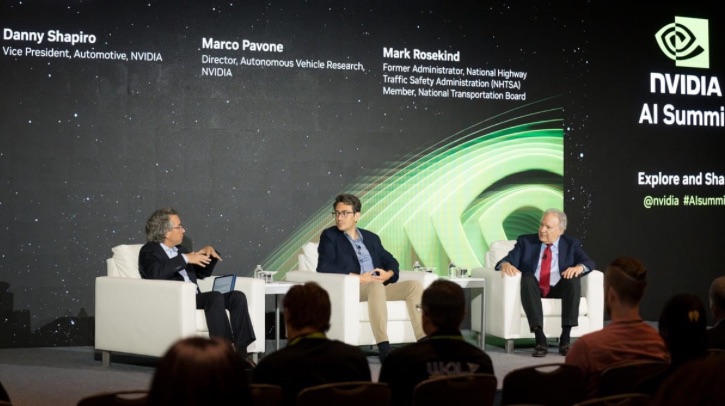The Nvidia AI Summit in Washington DC hosted a roster of industry experts who shared viewpoints on the AV safety landscape from regulatory and technology perspectives.
Danny Shapiro, VP of automotive at Nvidia, led the conversation with Mark Rosekind, former administrator of the National Highway Traffic Safety Administration, and Marco Pavone, director of AV research at Nvidia.
“Improving safety on our roads is critical,” Shapiro said, noting that Nvidia has been working for over two decades with the auto industry, including on ADAS and fully autonomous driving technology development.
Nvidia’s approach to AV development is centered on the integration of three computers: one for training the AI, one for simulation to test and validate the AI, and one in the vehicle to process data in real time to make safe decisions. Together, these systems enable continuous development cycles, always improving the AV software in performance and safety.
Rosekind commented on regulations that exist across the USA, explaining that federal agencies focus on the vehicle, while the states focus on the operator, including driver education, insurance and licensing. Pavone discussed the emergence of new tools that enable researchers and developers to rethink how AV development is carried out.
Another topic also discussed during the panel was the announcement made at the AI Summit that government-sponsored non-profit Mitre was partnering with Mcity at the University of Michigan to develop a virtual and physical AV validation platform for industry deployment.
Mitre will use Mcity’s simulation tools and a digital twin of its Mcity test facility, a real-world AV test environment in its digital proving ground. The co-developed platform will deliver physically-based sensor simulation, enabled by Nvidia Omniverse Cloud Sensor RTX applications programming interfaces.
Rosekind said that the Mite announcement “represents an opportunity to have a trusted source who’s done this in many other areas, especially in aviation, to create an independent, neutral setting to test safety assurance”.
Shapiro said, “That’s the beauty of simulation. It’s repeatable, it’s controllable. We can control the weather in the simulation. We can change the time of day, and then we can control all the scenarios and inject hazards. Once the simulation is created, we can run it over and over, and as the software develops, we can ensure we are solving the problem and can fine-tune as necessary.”
The panel concluded with a reminder that the key goal of autonomous driving is one that businesses and regulators alike share: to reduce death and injuries on our roads.


